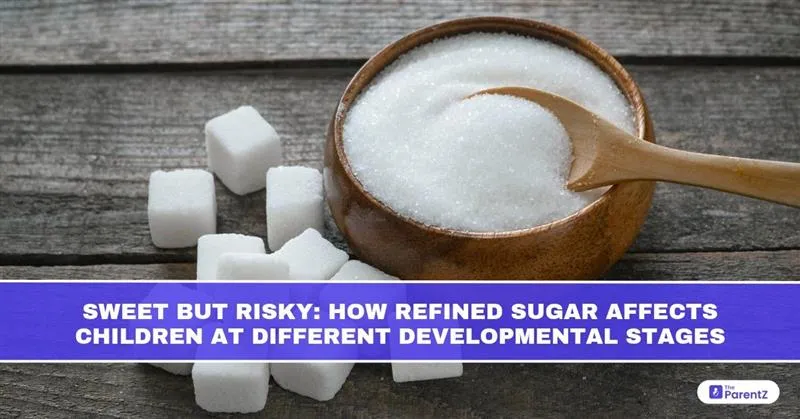The Unseen Impact of Everyday Sweetness
From the first birthday cake to post-school biscuits, sugar is stitched into most children’s routines. Whether it’s in the form of packaged snacks, juices, or celebratory sweets, refined sugar is often part of childhood. While occasional indulgence is not the issue, regular and early exposure to refined sugar creates risks that build silently over time.
As a dental professional who frequently treats children, I’ve seen how sugar affects not only teeth but also eating behaviour, immunity, and even school performance. The impact varies depending on the child’s age and stage of development, which makes understanding sugar’s timeline especially important for parents.
What Exactly Is Refined Sugar?
Refined sugar refers to sugars that are extracted, processed, and stripped of all nutrients. Common sources include:
- White sugar
- High-fructose corn syrup
- Glucose-fructose syrups
- Brown sugar (still refined)
- Malt-based sweeteners in children’s drinks
These sugars are present in:
- Sweets, chocolates
- Packaged cereals and energy bars
- Bakery items
- Sweetened milk powders and drinks
- Flavored curd, sauces, jams, ketchup
- Even medications like cough syrup
Unlike natural sugars found in fruits and milk, refined sugar offers calories without nutrition.
Sugar’s Effect by Age: A Stage-Wise Look
Infants (0–12 Months)
Refined sugar has no role in infancy. Babies are born with an undeveloped gut and should not be exposed to processed sugars. Introducing sweeteners too early:
- Can interfere with the development of taste preferences
- May increase the risk of early dental caries (especially if bottle-fed to sleep)
- Disrupts the establishment of healthy gut bacteria
Tip: Avoid sweetening cow’s milk or ragi porridge. Let natural taste develop.
Toddlers (1–3 Years)
At this stage, children are learning to explore textures and flavours. Introducing sugar here:
- Builds preference for sweet-tasting foods
- Reduces acceptance of vegetables and less sweet fruits
- Leads to risk of “nibbling habits,” where a child seeks frequent small sweet snacks
Dentally, this is when early childhood caries often begins, particularly if children are offered sweetened liquids in bottles or sippers.
Clinical Insight: Most toddlers I treat with tooth decay have a visible sugar routine, sweetened milk at bedtime, or biscuits and health drinks during the day.
Preschoolers (4–6 Years)
Children in this age group become more social eaters, and what they see in tiffins or birthday parties influences their preferences. Frequent sugar intake now:
- Increases risk of visible plaque and enamel damage
- Can lead to energy highs and sudden crashes affecting mood and attention
- Encourages daily sweet intake as a norm
At this stage, children also start self-feeding and may sneak sugar from kitchen shelves or friend’s lunchboxes.
Oral hygiene often becomes inconsistent, and if sweet snacks are not followed by brushing or rinsing, cavities form quickly.
Primary School Age (7–10 Years)
As children grow more independent, their exposure to sugary products often rises. This is the age where:
- Hidden sugars in packaged foods dominate diets
- Tendency to skip meals and replace them with “energy snacks” increases
- Dental decay spreads between molars, which are difficult for kids to clean thoroughly
Sugar overconsumption here can also interfere with immunity and concentration, making children more prone to infections or poor focus in school.
Observation: Children who frequently miss school due to illness or show signs of sluggishness often have an unbalanced, sugar-heavy diet.
Tweens and Teens (11–16 Years)
This is when habits start mimicking those of adults. Sugar intake may now come from:
- Soft drinks
- Milkshakes, frappes
- Bakery items during tuition breaks
- Sugary protein bars or “fitness drinks”
While physical activity increases, so does stress, peer pressure, and irregular meals. Excess sugar during these years:
- Increases the risk of insulin resistance
- Affects hormone balance (especially in girls with early PCOS symptoms)
- Leads to acid erosion of teeth due to fizzy drinks
This group also tends to underplay dental pain, leading to larger cavities and early dental procedures.
Beyond Teeth: Whole-Body Effects of Sugar
Refined sugar does more than cause dental issues. It contributes to:
- Fatigue and mood swings due to blood sugar fluctuations
- Poor satiety, making children feel hungry even after eating
- Nutrient displacement, where the child fills up on sugar-rich foods and skips iron, calcium, and protein
- Obesity and early metabolic risks, especially when paired with low physical activity
Dental Red Flags to Watch For
As a dentist, here are early indicators of sugar overload I frequently notice:
- Multiple decayed teeth in both front and back areas
- Inflamed or bleeding gums
- White spots or chalky patches near the gumline (early enamel demineralization)
- Complaints of tooth sensitivity to cold or sweet foods
- Bad breath even after brushing
How to Cut Sugar Without Making Food Boring
Parents often fear that reducing sugar will make food unappealing. But it’s possible to offer variety and taste without refined sweeteners.
- Replace white sugar with natural sweetness: dates, bananas, raisins, jaggery in moderation
- Offer whole fruit instead of juice
- Choose plain milk or curd over flavored versions
- Introduce spice-based sweets (like elaichi or cinnamon) for flavor
- Involve children in cooking simple homemade snacks like coconut laddoos, whole wheat pancakes, or ragi cookies
What Guidelines Say
- WHO recommends that free sugars should make up less than 10% of total daily energy intake for children and ideally below 5%
- For a child aged 4–10, that’s no more than 20–25 grams of sugar per day (roughly 5–6 teaspoons)
- A small glass of flavored milk or a packet of biscuits can exceed this limit easily
Final Word: A Mindful Approach, Not a Sugar Ban
“In my practice, I often tell parents, it’s not about cutting all sweets but knowing how often they show up. A treat once a week won’t harm. But a sweet after every meal? That’s a problem.” Children don’t need to be deprived but they do need guidance. Let sugar be something to enjoy occasionally, not something they need daily to feel satisfied or energetic. Encouraging whole foods, modeling good eating habits, and paying attention to oral hygiene are the best tools we have to protect our children both inside and out.









Be the first one to comment on this story.